Clinical Governance: Principles and Application Essay
VerifiedAdded on 2022/08/23
|6
|1495
|29
Essay
AI Summary
This essay delves into the concept of clinical governance, emphasizing its role in continuously improving healthcare systems to ensure high standards of patient care and accountability. It outlines the principles of clinical governance, including clinical governance knowledge, unity of command, and understanding the economy of governance. The essay discusses the seven pillars of clinical governance: clinical effectiveness, audit, risk management, education and training, patient-public involvement, information and IT, and staff management. It highlights the challenges in bridging the gap between the theoretical framework and practical application, particularly in balancing economic needs with quality patient care, and the importance of the National Safety and Quality Health Service (NSQHS) standards. The essay provides a case study from the author's experience as a team leader, illustrating the practical application of clinical governance principles and the need for improved communication and staff partnership. The essay concludes by emphasizing the importance of clinical governance in nursing and healthcare, advocating for objective assessment and continuous improvement in clinical service delivery.
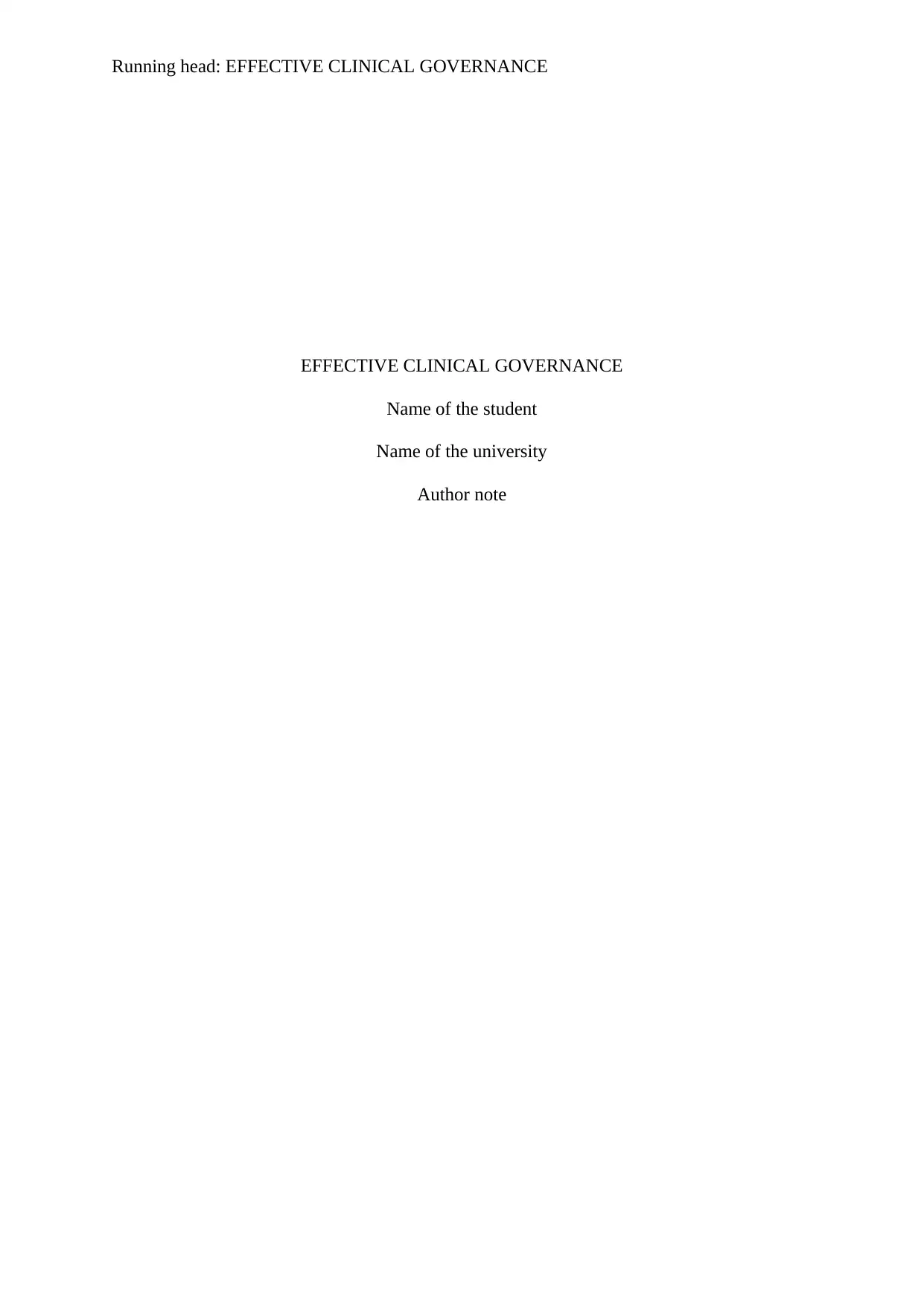
Running head: EFFECTIVE CLINICAL GOVERNANCE
EFFECTIVE CLINICAL GOVERNANCE
Name of the student
Name of the university
Author note
EFFECTIVE CLINICAL GOVERNANCE
Name of the student
Name of the university
Author note
Paraphrase This Document
Need a fresh take? Get an instant paraphrase of this document with our AI Paraphraser
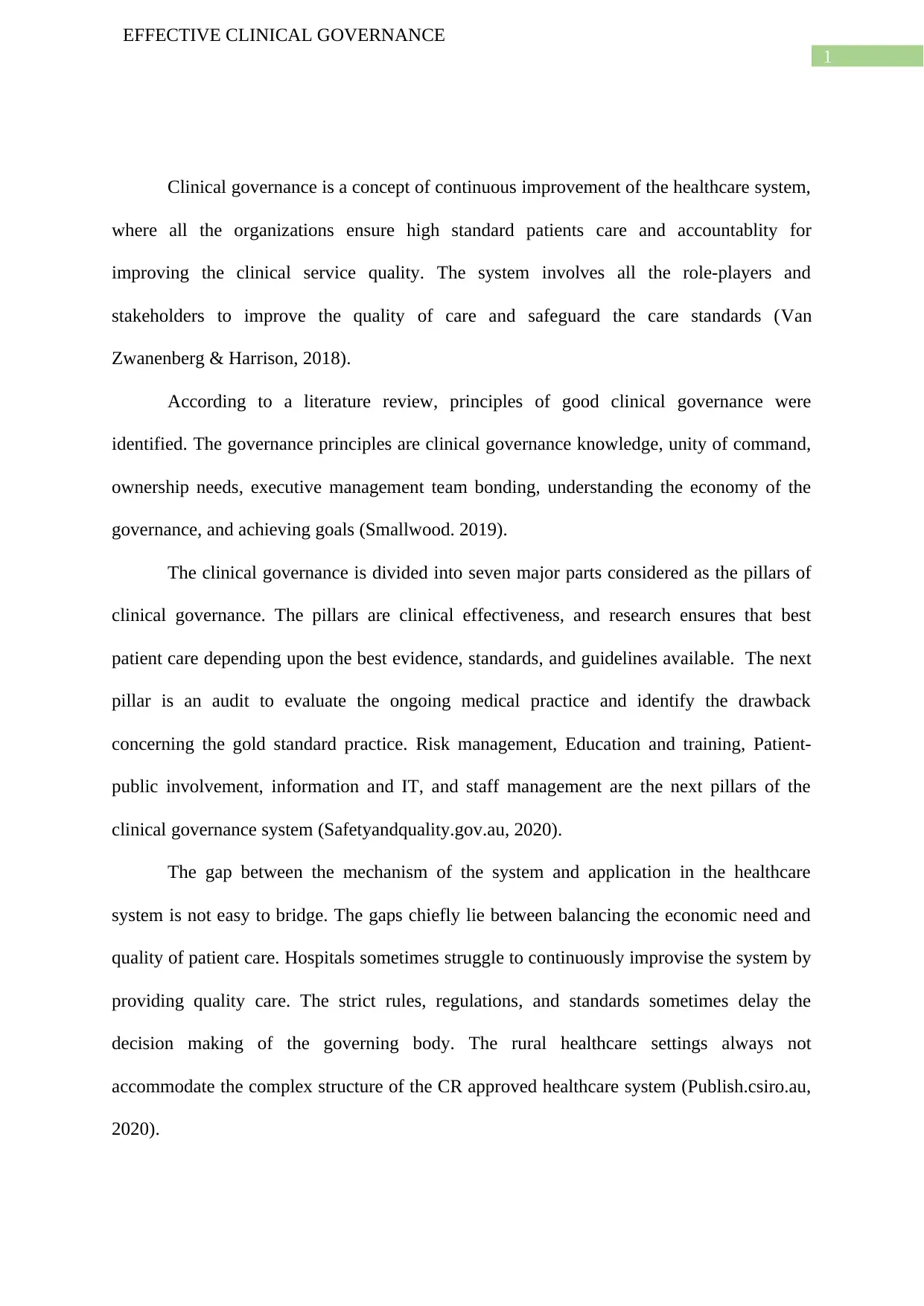
1
EFFECTIVE CLINICAL GOVERNANCE
Clinical governance is a concept of continuous improvement of the healthcare system,
where all the organizations ensure high standard patients care and accountablity for
improving the clinical service quality. The system involves all the role-players and
stakeholders to improve the quality of care and safeguard the care standards (Van
Zwanenberg & Harrison, 2018).
According to a literature review, principles of good clinical governance were
identified. The governance principles are clinical governance knowledge, unity of command,
ownership needs, executive management team bonding, understanding the economy of the
governance, and achieving goals (Smallwood. 2019).
The clinical governance is divided into seven major parts considered as the pillars of
clinical governance. The pillars are clinical effectiveness, and research ensures that best
patient care depending upon the best evidence, standards, and guidelines available. The next
pillar is an audit to evaluate the ongoing medical practice and identify the drawback
concerning the gold standard practice. Risk management, Education and training, Patient-
public involvement, information and IT, and staff management are the next pillars of the
clinical governance system (Safetyandquality.gov.au, 2020).
The gap between the mechanism of the system and application in the healthcare
system is not easy to bridge. The gaps chiefly lie between balancing the economic need and
quality of patient care. Hospitals sometimes struggle to continuously improvise the system by
providing quality care. The strict rules, regulations, and standards sometimes delay the
decision making of the governing body. The rural healthcare settings always not
accommodate the complex structure of the CR approved healthcare system (Publish.csiro.au,
2020).
EFFECTIVE CLINICAL GOVERNANCE
Clinical governance is a concept of continuous improvement of the healthcare system,
where all the organizations ensure high standard patients care and accountablity for
improving the clinical service quality. The system involves all the role-players and
stakeholders to improve the quality of care and safeguard the care standards (Van
Zwanenberg & Harrison, 2018).
According to a literature review, principles of good clinical governance were
identified. The governance principles are clinical governance knowledge, unity of command,
ownership needs, executive management team bonding, understanding the economy of the
governance, and achieving goals (Smallwood. 2019).
The clinical governance is divided into seven major parts considered as the pillars of
clinical governance. The pillars are clinical effectiveness, and research ensures that best
patient care depending upon the best evidence, standards, and guidelines available. The next
pillar is an audit to evaluate the ongoing medical practice and identify the drawback
concerning the gold standard practice. Risk management, Education and training, Patient-
public involvement, information and IT, and staff management are the next pillars of the
clinical governance system (Safetyandquality.gov.au, 2020).
The gap between the mechanism of the system and application in the healthcare
system is not easy to bridge. The gaps chiefly lie between balancing the economic need and
quality of patient care. Hospitals sometimes struggle to continuously improvise the system by
providing quality care. The strict rules, regulations, and standards sometimes delay the
decision making of the governing body. The rural healthcare settings always not
accommodate the complex structure of the CR approved healthcare system (Publish.csiro.au,
2020).
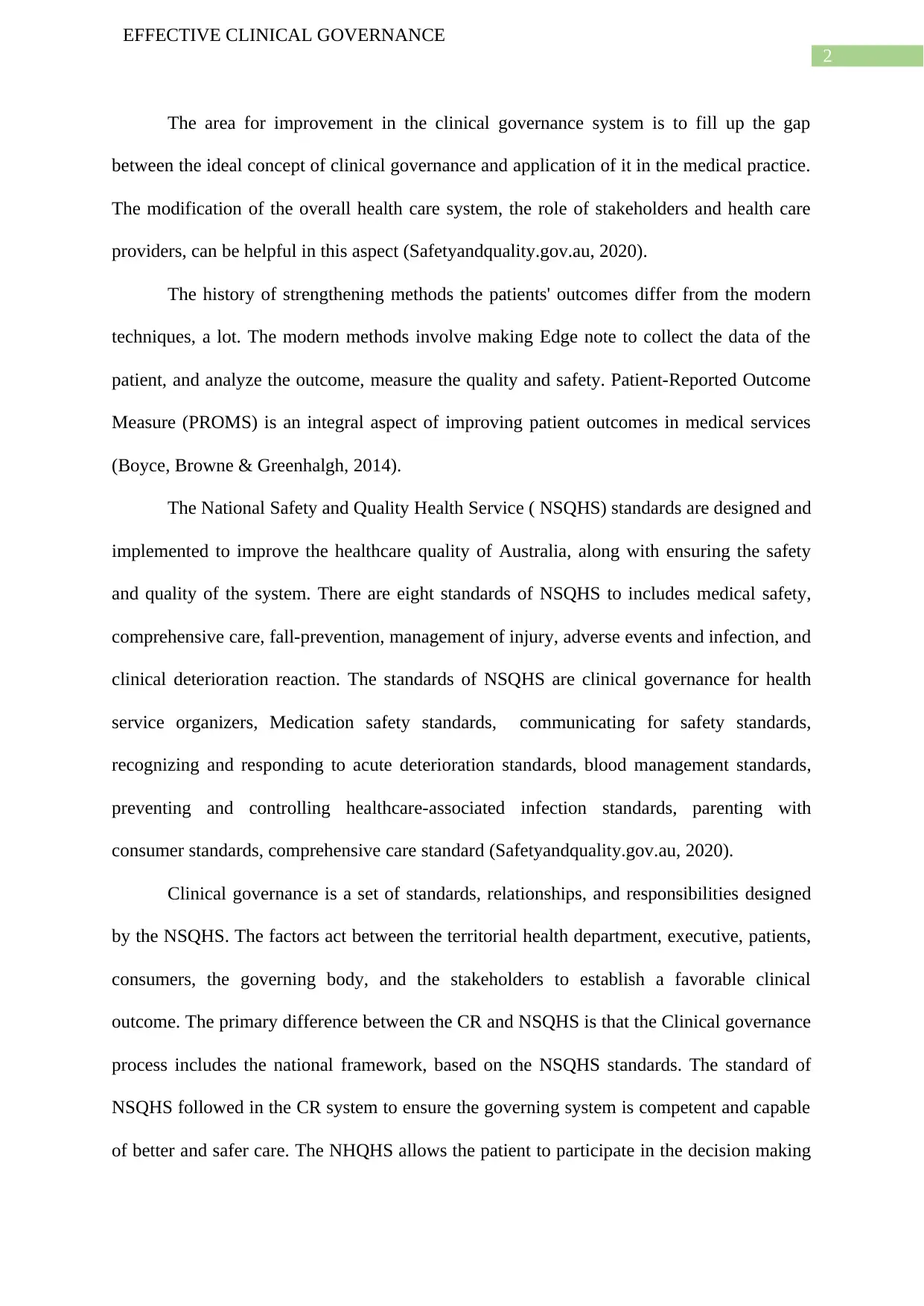
2
EFFECTIVE CLINICAL GOVERNANCE
The area for improvement in the clinical governance system is to fill up the gap
between the ideal concept of clinical governance and application of it in the medical practice.
The modification of the overall health care system, the role of stakeholders and health care
providers, can be helpful in this aspect (Safetyandquality.gov.au, 2020).
The history of strengthening methods the patients' outcomes differ from the modern
techniques, a lot. The modern methods involve making Edge note to collect the data of the
patient, and analyze the outcome, measure the quality and safety. Patient-Reported Outcome
Measure (PROMS) is an integral aspect of improving patient outcomes in medical services
(Boyce, Browne & Greenhalgh, 2014).
The National Safety and Quality Health Service ( NSQHS) standards are designed and
implemented to improve the healthcare quality of Australia, along with ensuring the safety
and quality of the system. There are eight standards of NSQHS to includes medical safety,
comprehensive care, fall-prevention, management of injury, adverse events and infection, and
clinical deterioration reaction. The standards of NSQHS are clinical governance for health
service organizers, Medication safety standards, communicating for safety standards,
recognizing and responding to acute deterioration standards, blood management standards,
preventing and controlling healthcare-associated infection standards, parenting with
consumer standards, comprehensive care standard (Safetyandquality.gov.au, 2020).
Clinical governance is a set of standards, relationships, and responsibilities designed
by the NSQHS. The factors act between the territorial health department, executive, patients,
consumers, the governing body, and the stakeholders to establish a favorable clinical
outcome. The primary difference between the CR and NSQHS is that the Clinical governance
process includes the national framework, based on the NSQHS standards. The standard of
NSQHS followed in the CR system to ensure the governing system is competent and capable
of better and safer care. The NHQHS allows the patient to participate in the decision making
EFFECTIVE CLINICAL GOVERNANCE
The area for improvement in the clinical governance system is to fill up the gap
between the ideal concept of clinical governance and application of it in the medical practice.
The modification of the overall health care system, the role of stakeholders and health care
providers, can be helpful in this aspect (Safetyandquality.gov.au, 2020).
The history of strengthening methods the patients' outcomes differ from the modern
techniques, a lot. The modern methods involve making Edge note to collect the data of the
patient, and analyze the outcome, measure the quality and safety. Patient-Reported Outcome
Measure (PROMS) is an integral aspect of improving patient outcomes in medical services
(Boyce, Browne & Greenhalgh, 2014).
The National Safety and Quality Health Service ( NSQHS) standards are designed and
implemented to improve the healthcare quality of Australia, along with ensuring the safety
and quality of the system. There are eight standards of NSQHS to includes medical safety,
comprehensive care, fall-prevention, management of injury, adverse events and infection, and
clinical deterioration reaction. The standards of NSQHS are clinical governance for health
service organizers, Medication safety standards, communicating for safety standards,
recognizing and responding to acute deterioration standards, blood management standards,
preventing and controlling healthcare-associated infection standards, parenting with
consumer standards, comprehensive care standard (Safetyandquality.gov.au, 2020).
Clinical governance is a set of standards, relationships, and responsibilities designed
by the NSQHS. The factors act between the territorial health department, executive, patients,
consumers, the governing body, and the stakeholders to establish a favorable clinical
outcome. The primary difference between the CR and NSQHS is that the Clinical governance
process includes the national framework, based on the NSQHS standards. The standard of
NSQHS followed in the CR system to ensure the governing system is competent and capable
of better and safer care. The NHQHS allows the patient to participate in the decision making
⊘ This is a preview!⊘
Do you want full access?
Subscribe today to unlock all pages.

Trusted by 1+ million students worldwide
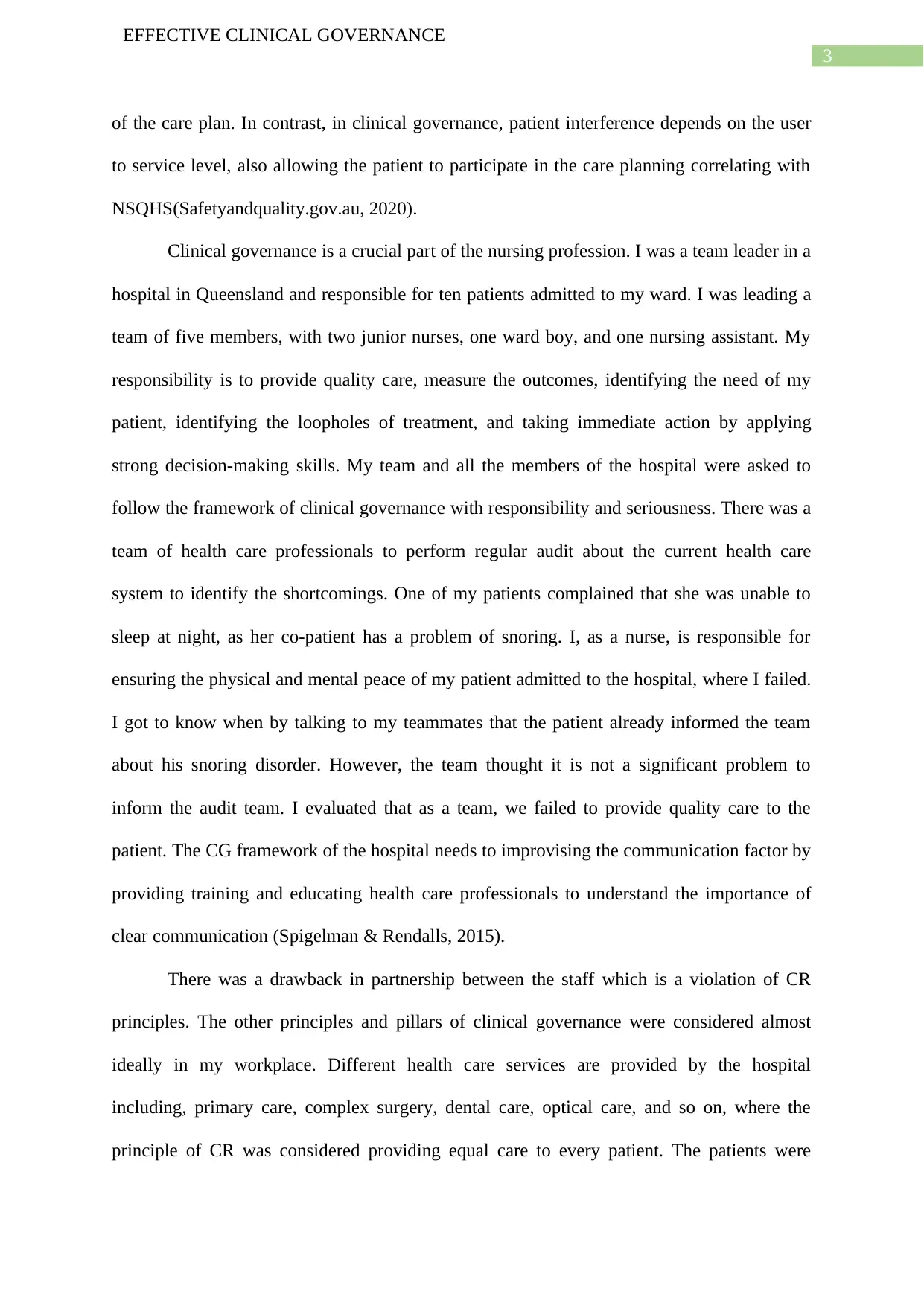
3
EFFECTIVE CLINICAL GOVERNANCE
of the care plan. In contrast, in clinical governance, patient interference depends on the user
to service level, also allowing the patient to participate in the care planning correlating with
NSQHS(Safetyandquality.gov.au, 2020).
Clinical governance is a crucial part of the nursing profession. I was a team leader in a
hospital in Queensland and responsible for ten patients admitted to my ward. I was leading a
team of five members, with two junior nurses, one ward boy, and one nursing assistant. My
responsibility is to provide quality care, measure the outcomes, identifying the need of my
patient, identifying the loopholes of treatment, and taking immediate action by applying
strong decision-making skills. My team and all the members of the hospital were asked to
follow the framework of clinical governance with responsibility and seriousness. There was a
team of health care professionals to perform regular audit about the current health care
system to identify the shortcomings. One of my patients complained that she was unable to
sleep at night, as her co-patient has a problem of snoring. I, as a nurse, is responsible for
ensuring the physical and mental peace of my patient admitted to the hospital, where I failed.
I got to know when by talking to my teammates that the patient already informed the team
about his snoring disorder. However, the team thought it is not a significant problem to
inform the audit team. I evaluated that as a team, we failed to provide quality care to the
patient. The CG framework of the hospital needs to improvising the communication factor by
providing training and educating health care professionals to understand the importance of
clear communication (Spigelman & Rendalls, 2015).
There was a drawback in partnership between the staff which is a violation of CR
principles. The other principles and pillars of clinical governance were considered almost
ideally in my workplace. Different health care services are provided by the hospital
including, primary care, complex surgery, dental care, optical care, and so on, where the
principle of CR was considered providing equal care to every patient. The patients were
EFFECTIVE CLINICAL GOVERNANCE
of the care plan. In contrast, in clinical governance, patient interference depends on the user
to service level, also allowing the patient to participate in the care planning correlating with
NSQHS(Safetyandquality.gov.au, 2020).
Clinical governance is a crucial part of the nursing profession. I was a team leader in a
hospital in Queensland and responsible for ten patients admitted to my ward. I was leading a
team of five members, with two junior nurses, one ward boy, and one nursing assistant. My
responsibility is to provide quality care, measure the outcomes, identifying the need of my
patient, identifying the loopholes of treatment, and taking immediate action by applying
strong decision-making skills. My team and all the members of the hospital were asked to
follow the framework of clinical governance with responsibility and seriousness. There was a
team of health care professionals to perform regular audit about the current health care
system to identify the shortcomings. One of my patients complained that she was unable to
sleep at night, as her co-patient has a problem of snoring. I, as a nurse, is responsible for
ensuring the physical and mental peace of my patient admitted to the hospital, where I failed.
I got to know when by talking to my teammates that the patient already informed the team
about his snoring disorder. However, the team thought it is not a significant problem to
inform the audit team. I evaluated that as a team, we failed to provide quality care to the
patient. The CG framework of the hospital needs to improvising the communication factor by
providing training and educating health care professionals to understand the importance of
clear communication (Spigelman & Rendalls, 2015).
There was a drawback in partnership between the staff which is a violation of CR
principles. The other principles and pillars of clinical governance were considered almost
ideally in my workplace. Different health care services are provided by the hospital
including, primary care, complex surgery, dental care, optical care, and so on, where the
principle of CR was considered providing equal care to every patient. The patients were
Paraphrase This Document
Need a fresh take? Get an instant paraphrase of this document with our AI Paraphraser
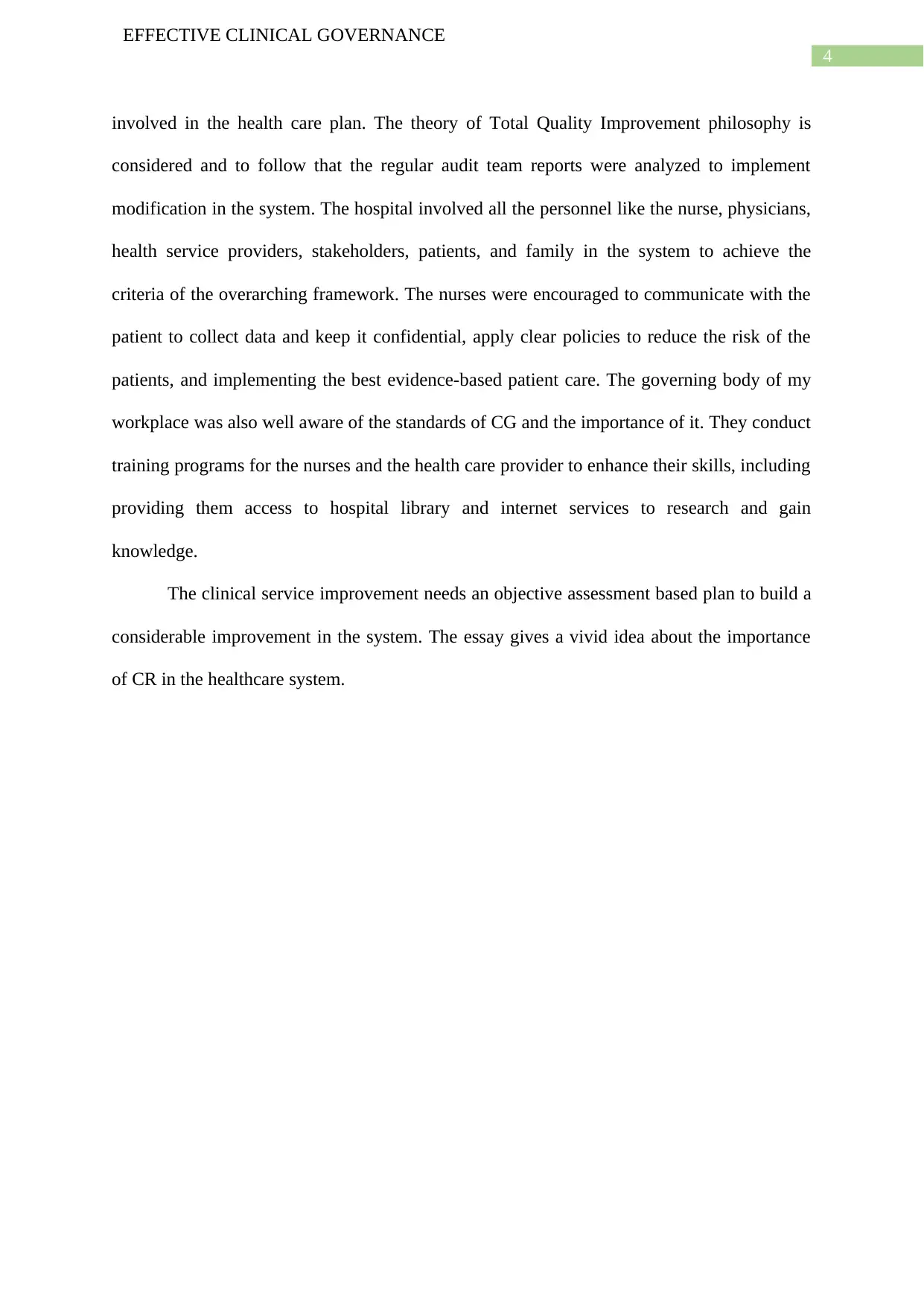
4
EFFECTIVE CLINICAL GOVERNANCE
involved in the health care plan. The theory of Total Quality Improvement philosophy is
considered and to follow that the regular audit team reports were analyzed to implement
modification in the system. The hospital involved all the personnel like the nurse, physicians,
health service providers, stakeholders, patients, and family in the system to achieve the
criteria of the overarching framework. The nurses were encouraged to communicate with the
patient to collect data and keep it confidential, apply clear policies to reduce the risk of the
patients, and implementing the best evidence-based patient care. The governing body of my
workplace was also well aware of the standards of CG and the importance of it. They conduct
training programs for the nurses and the health care provider to enhance their skills, including
providing them access to hospital library and internet services to research and gain
knowledge.
The clinical service improvement needs an objective assessment based plan to build a
considerable improvement in the system. The essay gives a vivid idea about the importance
of CR in the healthcare system.
EFFECTIVE CLINICAL GOVERNANCE
involved in the health care plan. The theory of Total Quality Improvement philosophy is
considered and to follow that the regular audit team reports were analyzed to implement
modification in the system. The hospital involved all the personnel like the nurse, physicians,
health service providers, stakeholders, patients, and family in the system to achieve the
criteria of the overarching framework. The nurses were encouraged to communicate with the
patient to collect data and keep it confidential, apply clear policies to reduce the risk of the
patients, and implementing the best evidence-based patient care. The governing body of my
workplace was also well aware of the standards of CG and the importance of it. They conduct
training programs for the nurses and the health care provider to enhance their skills, including
providing them access to hospital library and internet services to research and gain
knowledge.
The clinical service improvement needs an objective assessment based plan to build a
considerable improvement in the system. The essay gives a vivid idea about the importance
of CR in the healthcare system.
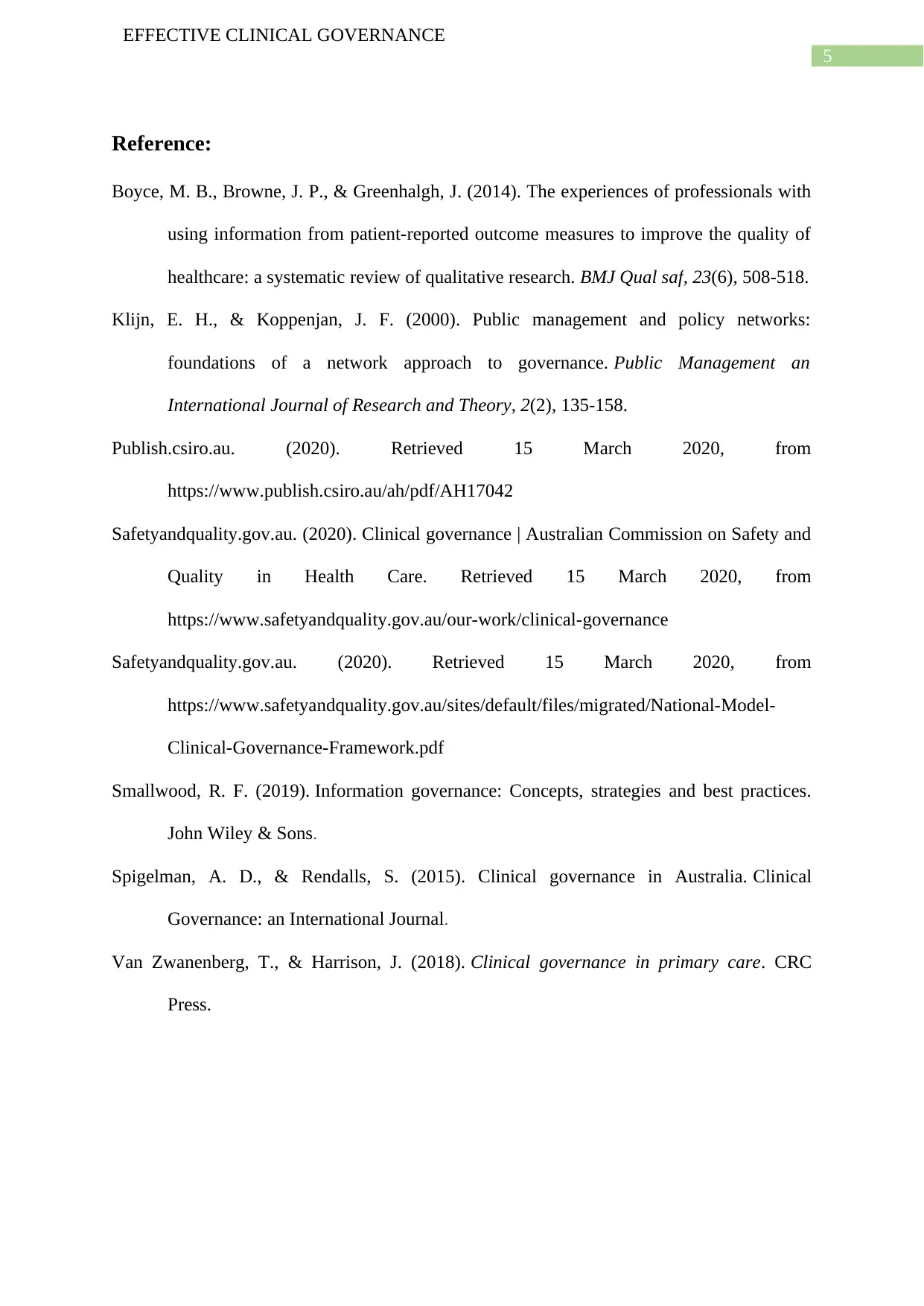
5
EFFECTIVE CLINICAL GOVERNANCE
Reference:
Boyce, M. B., Browne, J. P., & Greenhalgh, J. (2014). The experiences of professionals with
using information from patient-reported outcome measures to improve the quality of
healthcare: a systematic review of qualitative research. BMJ Qual saf, 23(6), 508-518.
Klijn, E. H., & Koppenjan, J. F. (2000). Public management and policy networks:
foundations of a network approach to governance. Public Management an
International Journal of Research and Theory, 2(2), 135-158.
Publish.csiro.au. (2020). Retrieved 15 March 2020, from
https://www.publish.csiro.au/ah/pdf/AH17042
Safetyandquality.gov.au. (2020). Clinical governance | Australian Commission on Safety and
Quality in Health Care. Retrieved 15 March 2020, from
https://www.safetyandquality.gov.au/our-work/clinical-governance
Safetyandquality.gov.au. (2020). Retrieved 15 March 2020, from
https://www.safetyandquality.gov.au/sites/default/files/migrated/National-Model-
Clinical-Governance-Framework.pdf
Smallwood, R. F. (2019). Information governance: Concepts, strategies and best practices.
John Wiley & Sons.
Spigelman, A. D., & Rendalls, S. (2015). Clinical governance in Australia. Clinical
Governance: an International Journal.
Van Zwanenberg, T., & Harrison, J. (2018). Clinical governance in primary care. CRC
Press.
EFFECTIVE CLINICAL GOVERNANCE
Reference:
Boyce, M. B., Browne, J. P., & Greenhalgh, J. (2014). The experiences of professionals with
using information from patient-reported outcome measures to improve the quality of
healthcare: a systematic review of qualitative research. BMJ Qual saf, 23(6), 508-518.
Klijn, E. H., & Koppenjan, J. F. (2000). Public management and policy networks:
foundations of a network approach to governance. Public Management an
International Journal of Research and Theory, 2(2), 135-158.
Publish.csiro.au. (2020). Retrieved 15 March 2020, from
https://www.publish.csiro.au/ah/pdf/AH17042
Safetyandquality.gov.au. (2020). Clinical governance | Australian Commission on Safety and
Quality in Health Care. Retrieved 15 March 2020, from
https://www.safetyandquality.gov.au/our-work/clinical-governance
Safetyandquality.gov.au. (2020). Retrieved 15 March 2020, from
https://www.safetyandquality.gov.au/sites/default/files/migrated/National-Model-
Clinical-Governance-Framework.pdf
Smallwood, R. F. (2019). Information governance: Concepts, strategies and best practices.
John Wiley & Sons.
Spigelman, A. D., & Rendalls, S. (2015). Clinical governance in Australia. Clinical
Governance: an International Journal.
Van Zwanenberg, T., & Harrison, J. (2018). Clinical governance in primary care. CRC
Press.
⊘ This is a preview!⊘
Do you want full access?
Subscribe today to unlock all pages.

Trusted by 1+ million students worldwide
1 out of 6
Related Documents
Your All-in-One AI-Powered Toolkit for Academic Success.
+13062052269
info@desklib.com
Available 24*7 on WhatsApp / Email
![[object Object]](/_next/static/media/star-bottom.7253800d.svg)
Unlock your academic potential
Copyright © 2020–2025 A2Z Services. All Rights Reserved. Developed and managed by ZUCOL.





